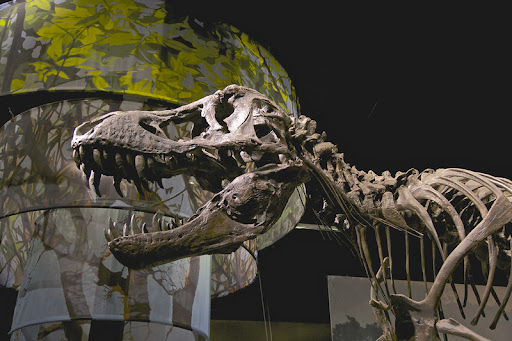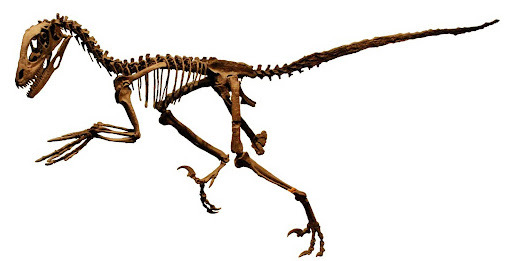For more crisp and insightful business and economic news, subscribe to The Daily Upside newsletter. It's completely free and we guarantee you'll learn something new every day.
The fantastically wealthy have always splashed out on lavish commodities – limited edition sports cars, bottles of wine that belonged to various founding fathers, maybe the occasional Rothko. But one particular investment, 66 million years in the making, has seen its popularity among super-wealthy buyers skyrocket, proving that millionaires do in fact move in herds.
The price of dinosaur fossils sold at private auctions has been soaring since 1997, when a Tyrannosaurus rex skeleton named "Sue" sold for almost $8.4 million -- equivalent to around $14.5 million in today's dollars. Before the sale of Sue, most fossils went for a maximum of around $200,000. Fast-forward to 2020, when another T. rex, named "Stan," sold for a gargantuan $31.8 million, more than doubling the 1997 price even adjusted for inflation. But is the fossilized bone mania sustainable? Or are we staring at a potential extinction level event?
So unleash the beasts! The park is open. Sit down, relax, and try not to move (they can't see you if you don't move) while we dig down into the fascinating world of fossil economics.
Fossil Gold Rush
This isn't the first time in history fossils have become a hot commodity. The word 'dinosaur' wasn't coined until 1842, and a few decades later the thirst for paleontological knowledge had grown so intense it became the stuff of period dramas.
In the late 1800s, a rivalry between two American paleontologists, Othniel Charles Marsh and Edward Drinker Cope (amazing names, we know), was so bitter it became known as "The Bone Wars." Both men raced around the American West trying to dig up more dinosaur bones than the other; the competition got so fierce they resorted to underhanded methods including bribing each other's workers, stealing, and even destroying fossil sites.
Marsh and Cope's feud financially ruined both men, but it was undeniably valuable to paleontology as they unearthed thousands of specimens. These days the fossil market is more likely to enrich a fossil-hunter than bankrupt them, but with far fewer benefits for science.
Spared No Expense...
The supply of fossils comes from a mix of professional paleontologists, amateur scientists, and commercial fossil hunters -- who sometimes butt heads with the scientific community. Paleontologist Riley Black told The Daily Upside part of that enmity comes from how US law treats fossils.
"One of the central issues here is that fossils have historically been treated similar to minerals or petroleum, particularly in the United States," she said. "We have a patchwork of laws that is meant to protect fossils on federal land -- like National Park and Bureau of Land Management land -- but does nothing to deter someone who finds a dinosaur on private property from selling it, destroying it, or whatever they wish."
"No wonder some people look at a dinosaur skeleton on their property and see a huge potential payday," Black added.
A popular marketplace for fossils is auction houses such as Sotheby's and Christie's, and certain species can reliably fetch eye-watering prices, most notably the Tyrant King.
"Tyrannosaurs are the dinosaurs everyone wants," Black said. "They are symbols of power and ferocity. Any carnivorous dinosaur will get more attention, as we've seen with some Allosaurus fossils, but people lose their minds when a T. rex is for sale." She pointed to a 2007 bidding war over a T. rex skull between Leonardo DiCaprio and Nicolas Cage. Cage emerged the victor, shelling out $270,000 for the cranium, but later had to return it to the government of Mongolia as the fossil had been illegally exported.

Even if T. rex is the big-ticket item, lesser dinosaurs can still fetch a high price:
- In May 2022 a Deinonychus skeleton sold for $12 million at Christie's. Deinonychus has some Hollywood caché, as it is sometimes viewed as the true dinosaur behind the misnamed velociraptors in Jurassic Park. The real velociraptor was only about two feet tall so it could barely reach a door handle, let alone turn it menacingly.
- Some auction houses are actively marketing fossils to private buyers. In September 2022 11-foot-tall Iguanodon skeleton sold at Parisian auction house Giquello for $660,738 after being touted as "a dinosaur for a living room." It's not often you see a prehistoric creature described like it's an Eames chair.

Traditional auction houses aren't the only marketplace for fossils. In 2019, a baby T. rex fossil was put up for sale on eBay for $3 million by commercial fossil hunter Alan Detrich, who told the WSJ he has "made millions of dollars in the dinosaur business."
National Geographic... uh... finds a way: Privately bought specimens often vanish into the houses (and presumably living rooms) of their owners, but sometimes they do resurface. In 2022, two years after Stan the T. rex was sold, National Geographic ingeniously tracked the skeleton down using US trade records, and discovered he had been shipped to Abu Dhabi. The city's Department of Culture and Tourism confirmed that Stan was due to make his debut at the local Natural History Museum, which is set to open in 2025. It's still not 100% clear who exactly owns Stan, but if it is the UAE, there's a bitter irony given the nation got rich off fossil fuels.
The Rise And Fall Of The Dinosaur Prices
As the dinosaurs themselves would tell you, what goes up must come down. The current macroeconomic climate is admittedly less calamitous than an asteroid strike, but it still ain't great.
A couple of disappointing sales at the tail-end of 2022 could indicate the fossil market is coming down from its Gulf State-induced high:
- November saw Christie's pull a T. rex skeleton named "Shen," slated to fetch between $15 million to $25 million, off the auction block after a paleontologist suggested some of Shen's bones bore a dubious similarity to Stan's. Christie's said Shen's consignor had decided to loan the skeleton to a museum instead.
- Sotheby's also suffered a Titanosaur-sized disappointment just a month later, when a Tyrannosaurus skull, which the auction house had pegged around the $20 million mark, sold for a measly $6.1 million. Cassandra Hatton, global head of science and popular culture at Sotheby's, told The New York Times the auction was "always designed to gauge the market."
Black told The Daily Upside the fossil market has long been unstable. In 2013 there was some speculation that prices would come down after an auction for a specimen called "The Duelling Dinosaurs" failed to reach the minimum bid, and awareness of illegally exported fossils (like Nic Cage's skull) became heightened -- but the sale of Stan showed just how volatile the market is.
It belongs in a museum! (Yes, we've changed Spielberg films): The bottom falling out of the fossil market would be music to the ears of researchers who have been increasingly priced out of the market. Private auctioning of fossils has decimated the supply of certain species for scientific research. According to paleontologist Thomas Carr, roughly 50% of all T. rex samples are owned by private collectors, many of whom squirrel them away out of sight.
Black said even when academic institutions can afford to buy a fossil, "such purchases reinforce the market value." She pointed to Sue the T. rex, which was bought by Chicago's Field Museum of Natural History.
While Black is pessimistic about prices dropping, she thinks some tighter regulations requiring scientifically important fossils to be documented and stored properly would be a good start.
"We're not in the 19th century anymore. The idea of the enterprising fossil hunter collecting specimens to sell to museums doesn't fit in the field anymore. Paleontology is slowly and painfully coming to the understanding that fossils are part of a history. We can't and shouldn't own as if tyrannosaurs were luxury cars," she added.
Or to paraphrase Ian Malcom, the Jurassic Park mathematician played by Jeff Goldblum: Investors were so preoccupied with whether or not they could, they aren't stopping to think whether they should.

